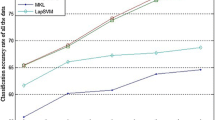Abstract
Manifold learning is a promising intelligent data analysis method, and the manifold learning preserves the local embedding features of the data in manifold mapping space. Manifold learning has its limitations on extracting the nonlinear features of the data in many applications. For example, hyperspectral image classification needs to seek the nonlinear local relationships between spectral curves. For that, researchers applied the kernel trick to manifold learning in the previous works. The kernel-based manifold learning was developed, but still endures the problem that the inappropriate kernel model reduces the system performance. In order to solve the problem of kernel model selection, we propose a manifold framework of multiple-kernel learning for the application of hyperspectral image classification. In this framework, the quasiconformal mapping-based multiple-kernel model is optimized based on the optimization objective equation, which maximizes the class discriminant ability of data. Accordingly, the discriminative structure of data distribution is achieved for classification with the quasiconformal mapping-based multiple-kernel model.




Similar content being viewed by others
References
Belhumeur PN, Hespanha JP, Kriegman DJ (1997) Eigenfaces vs. fisherfaces: recognition using class specific linear projection. IEEE Trans Pattern Anal Mach Intell 19(7):711–720
Batur AU, Hayes MH (2001) Linear subspace for illumination robust face recognition. In: Proceedings of the IEEE international conference on computer vision and pattern recognition, pp 296–301
Hastie T, Stuetzle W (1989) Principal curves. J Am Stat Assoc 84:502–516
Chang K-Y, Ghosh J (2001) A unified model for probabilistic principal surfaces. IEEE Trans Pattern Anal Mach Intell 23(1):22–41
Zhu Z, He H, Starzyk JA, Tseng C (2007) Self-organizing learning array and its application to economic and financial problems. Inf Sci 177(5):1180–1192
Yin H (2002) Data visualisation and manifold mapping using the ViSOM. Neural Netw 15(8):1005–1016
Roweis ST, Saul LK (2000) Nonlinear dimensionality reduction by locally linear embedding. Science 290:2323–2326
Tenenbaum JB, de Silva V, Langford JC (2000) A global geometric framework for nonlinear dimensionality reduction. Science 290:2319–2323
He X, Niyogi P (2003) Locality preserving projections. In: Proceedings of the conference on advances in neural information processing systems, pp 585–591
He X, Yan S, Hu Y, Niyogi P, Zhang H (2005) Face recognition using Laplacianfaces. IEEE Trans Pattern Anal Mach Intell 27(3):328–340
Li J-B, Pan J-S, Chu S-C (2008) Kernel class-wise locality preserving projection. Inf Sci 178(7):1825–1835
Mulier F, Cherkassky V (1995) Self-organization as an iterative kernel smoothing process. Neural Comput 7:1165–1177
Ritter H, Martinetz T, Schulten K (1992) Neural computation and self-organizing maps. Addison-Wesley, Reading, pp 64–72
Chen C, Li W, Hongjun S, Liu K (2014) Spectral–spatial classification of hyperspectral image based on kernel extreme learning machine. Remote Sens 6(6):5795–5814
Huang J, Yuen PC, Chen W-S, Lai JH (2004) Kernel subspace LDA with optimized kernel parameters on face recognition. In: Proceedings of the sixth IEEE international conference on automatic face and gesture recognition
Pan JS, Li JB, Lu ZM (2008) Adaptive quasiconformal kernel discriminant analysis. Neurocomputing 71(13–15):2754–2760
Chen W-S, Yuen PC, Huang J, Dai D-Q (2005) Kernel machine-based one-parameter regularized fisher discriminant method for face recognition. IEEE Trans Syst Man Cybern B Cybern 35(4):658–669
Xiong H, Swamy MN, Ahmad MO (2005) Optimizing the kernel in the empirical feature space. IEEE Trans Neural Netw 16(2):460–474
Amari S, Wu S (1999) Improving support vector machine classifiers by modifying kernel functions. Neural Netw 12(6):783–789
Li J-B, Pan J-S, Lu Z-M (2009) Kernel optimization-based discriminant analysis for face recognition. Neural Comput Appl 18(6):603–612
Xie X, Li B, Chai X (2015) Kernel-based nonparametric fisher classifier for hyperspectral remote sensing imagery. J Inf Hiding Multimed Signal Process 6(3):591–599
Subrahmanya N, Shin YC (2010) Sparse multiple kernel learning for signal processing applications. IEEE Trans Pattern Anal Mach Intell 32(5):788–798
Sonnenburg S, Rätsch G, Schäfer C, Schölkopf B (2006) Large scale multiple kernel learning. J Mach Learn Res 7:1531–1565
Kloft M, Brefeld U, Sonnenburg S, Zien A (2011) lp-Norm multiple kernel learning. J Mach Learn Res 12:953–997
Lin C, Jiang J, Zhao X, Pang M, Ma Y (2015) Supervised kernel optimized locality preserving projection with its application to face recognition and palm biometrics. Math Probl Eng. doi:10.1155/2015/421671
Koltchinskii V, Panchenko D (2002) Empirical margin distributions and bounding the generalization error of combined classifiers. Ann Stat 30(1):1–50
Wang L, Chan KL, Xue P (2005) A criterion for optimizing kernel parameters in KBDA for image retrieval. IEEE Trans Syst Man Cybern B Cybern 35(3):556–562
Cortes C, Mohri M, Rostamizadeh A (2012) Algorithms for learning kernels based on centered alignment. J Mach Learn Res 13(1):795–828
He Z, Li J (2015). Multiple data-dependent kernel for classification of hyperspectral images. Expert Syst Appl 42(3):1118–1135
Author information
Authors and Affiliations
Corresponding author
Rights and permissions
About this article
Cite this article
Xie, X., Li, B. & Chai, X. A manifold framework of multiple-kernel learning for hyperspectral image classification. Neural Comput & Applic 28, 3429–3439 (2017). https://doi.org/10.1007/s00521-016-2206-y
Received:
Accepted:
Published:
Issue Date:
DOI: https://doi.org/10.1007/s00521-016-2206-y




